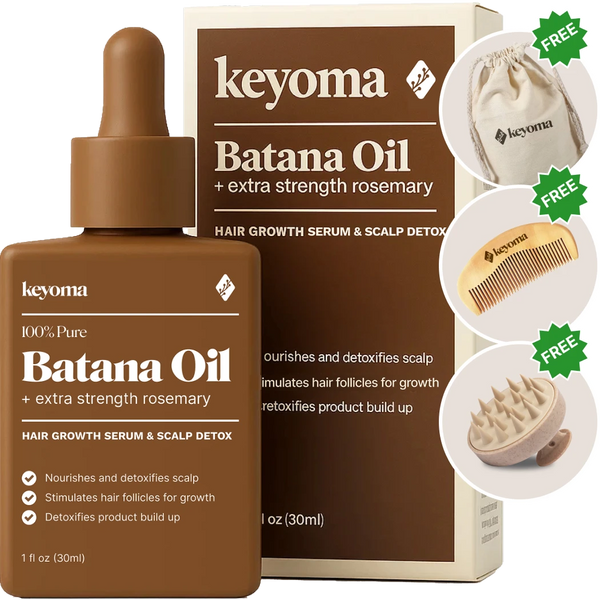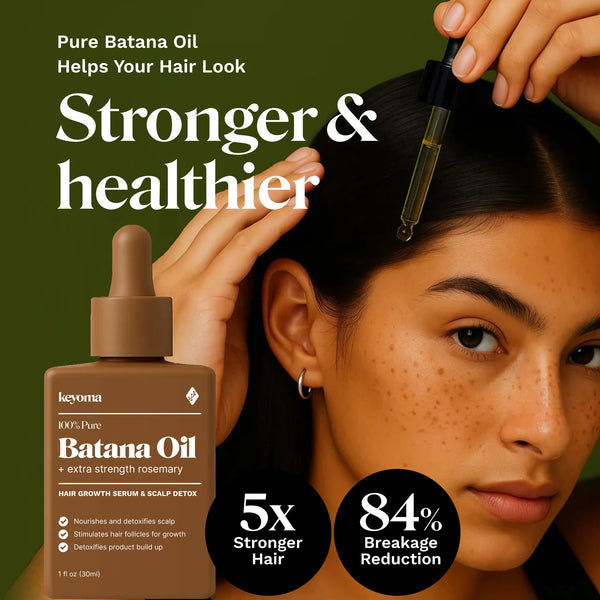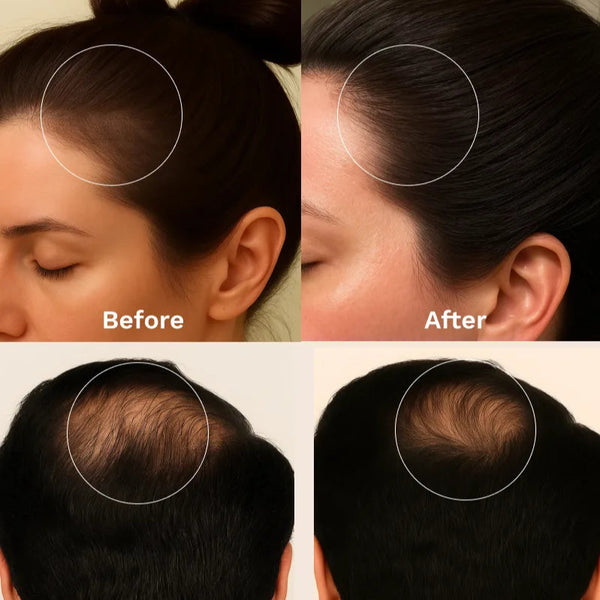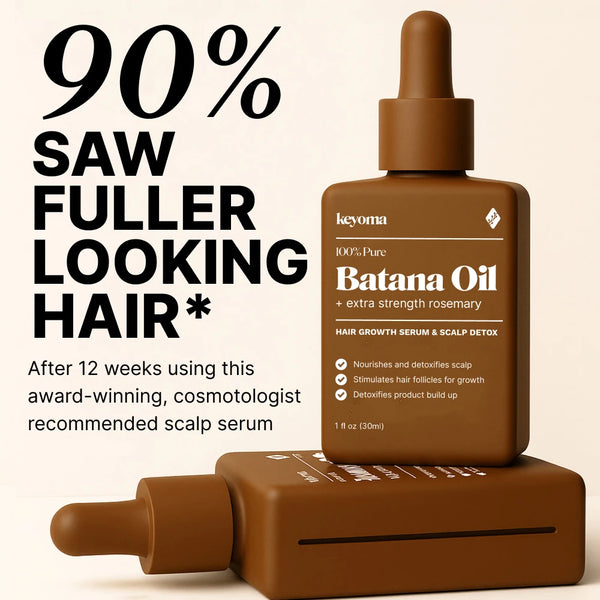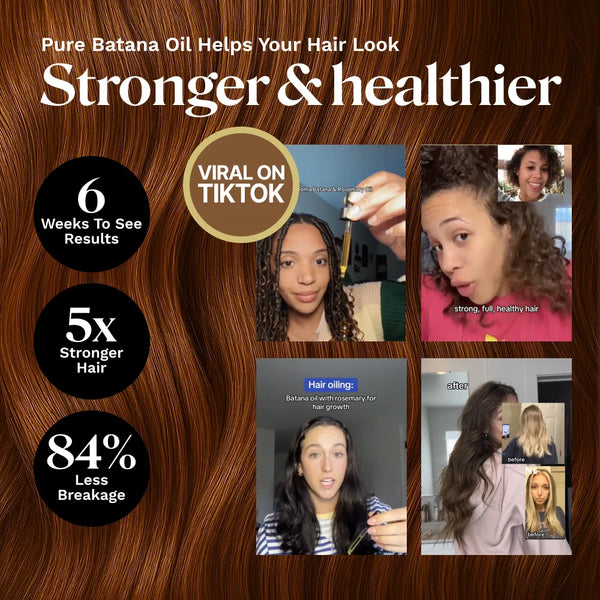In this article
Most scalp issues show up as shedding or a rash, and many run in families. Poor nutrition or infections can trigger problems too. The treatment and your outlook really depend on the root cause.
Let us guide you on how to spot whether your hair loss is scarring or non-scarring, match your symptoms to likely culprits, and choose your next move. Start with the comparison table, jump to the condition that feels most familiar, then follow the care steps and watch for red-flag warnings.
Key Takeaways
-
Scalp conditions can cause either temporary shedding or permanent hair loss, depending on whether follicles are scarred or intact.
-
Infections, autoimmune reactions, allergies, and chronic inflammation are common triggers.
-
Early recognition of symptoms such as itching, plaques, or patchy hair loss improves treatment outcomes.
-
Gentle scalp care, timely medical attention, and avoiding harsh products help protect follicle health.
Can Scalp Conditions Cause Hair Loss?
Yes. Scalp conditions can trigger hair loss by inflaming follicles or by making you scratch and break hairs. In infections like tinea capitis, the fungus lives in the hair shaft and weakens it. Inflammation from psoriasis, seborrheic dermatitis, or allergic reactions loosens hairs and increases shedding when you pick at scale.
Two paths matter. In non-scarring conditions, follicles stay alive and regrowth follows once you calm the trigger. In scarring conditions, ongoing inflammation destroys follicles and loss becomes permanent, so speed matters.
Watch for patterns and act early:
-
Itchy, flaky scalp with greasy scale points to seborrheic dermatitis. Use medicated shampoos as directed.
-
Thick plaques with silvery or gray scale suggest psoriasis. Soften scale before removal to limit breakage.
-
Patchy rash after hair dye or new products signals allergic contact dermatitis. Stop the trigger and ask about patch testing.
-
Round, scaly patches with broken hairs, pain, or a swollen kerion suggest tinea capitis. Oral antifungals treat the cause.
Keep nails short, avoid scratching, and choose gentle, fragrance-light products. If you see pain, pus, thick crusts, or rapidly expanding bare areas, book an evaluation.
Scarring vs Non-Scarring Alopecia
Here’s a side-by-side look at how these two types of hair loss differ in what causes them, how they appear on your scalp, and what treatment options they leave open for you:

What Is Scarring Alopecia
Scarring alopecia, or cicatricial alopecia, happens when your hair follicles get destroyed and replaced with scar tissue. Once that damage sets in, the follicles can’t recover, so hair loss in those spots becomes permanent.
Inflammation usually drives this process, and it can stem from autoimmune issues, infections, or other skin conditions. Because the damage occurs beneath your scalp’s surface, you may not notice anything early on—often, the shedding only stands out once the loss feels more obvious.
Scalp Conditions That Cause Scarring Hair Loss
-
Lichen planopilaris (LPP)
-
Frontal fibrosing alopecia (FFA)
-
Discoid lupus erythematosus (DLE)
-
Central centrifugal cicatricial alopecia (CCCA)
-
Folliculitis decalvans
These issues go far beyond appearance. You need timely medical care to slow them down and protect your scalp from further harm.
What Is Non-Scarring Alopecia
Non-scarring alopecia happens when your follicles stay intact and still have the ability to grow hair again. In many cases, you can reverse the loss with the right care, treatment, or even simple lifestyle changes.
This form of shedding shows up far more often than scarring types and usually traces back to internal shifts, like hormones or nutrition, or outside stressors you might not even realize are at play.
Scalp Conditions Linked to Non-Scarring Hair Loss
-
Androgenetic alopecia (male or female pattern baldness)
-
Telogen effluvium (stress-related hair shedding)
-
Alopecia areata (autoimmune hair loss in patches)
-
Trichotillomania (hair-pulling disorder)
-
Nutritional deficiencies
Since your hair roots stay alive in these situations, the right treatment usually encourages regrowth with time. I’ve seen people regain noticeable fullness after a few consistent months, which can be reassuring when you’re feeling uncertain about the future of your hair.
5 Common Scalp Conditions That Cause Hair Thinning
Now that we’ve outlined how scalp conditions can cause either temporary shedding or permanent loss, let’s look at the specific culprits. Each of these conditions affects the scalp in its own way, from speeding up skin cell turnover to triggering infections or immune reactions.
Understanding their signs will help you spot what’s happening on your own scalp and know when it’s time to seek treatment.
Head Lice

Head lice are tiny, wingless insects that survive by feeding on the blood from your scalp. They live in your hair, and if you’ve ever seen one up close, an adult louse looks about the size of a sesame seed. Their eggs, called nits, are even smaller—like little flakes of dandruff stuck to the strand.
Lice spread easily from person to person. You usually catch them when they crawl from someone else’s head onto yours. This often happens through:
-
direct head-to-head contact
-
sharing personal items like combs or brushes
-
using fabric items, such as hats, headbands, or even headphones, after someone with lice
Technically, lice can survive for a short while on furniture, bedding, towels, or clothing. But in reality, experts stress that close head-to-head contact is by far the main way they spread. That’s why kids often pass them around during play.
You might hear mixed opinions about lice transmission from objects, but most studies suggest it’s very rare. So while you’ll want to keep combs and hats personal, your bigger concern is contact with someone who already has lice.
Psoriasis

Scalp psoriasis speeds up skin cell turnover, which leads to thick patches or plaques on the scalp and sometimes other areas of your body. These plaques often show up at the hairline and the back of your head, but you may also notice them on your forehead, neck, or around your ears.
These plaques usually feel dry, raised, and flaky. You may also notice:
-
silvery-like scales
-
flaking that looks like stubborn dandruff
-
itching, burning, or irritation
-
bleeding or temporary shedding from scratching or trying to remove the plaques
Plaques can appear evenly across both sides of the scalp or spread across most of your head.
On lighter skin, psoriasis often looks like pink or red patches with silvery-white scales. On darker skin, it tends to appear as deep brown or purple patches with gray scales.
Tinea Capitis

The most common sign of scalp ringworm is an itchy patch that makes you scratch without thinking. Hair in those spots often snaps close to the scalp, leaving behind scaly, red patches or small bald spots. Sometimes you’ll notice tiny black dots where the hair broke off. If you don’t treat it, the patches can slowly expand and spread.
Other symptoms you might see include:
-
brittle, fragile hair
-
a sore or tender scalp
-
swollen lymph nodes
-
a low-grade fever
In more severe cases, you may develop painful, crusty swellings called kerion that ooze pus. These can leave lasting scars and permanent bald patches, which is why catching it early matters.
Alopecia Areata

Alopecia areata usually first shows up between ages 25 and 36. The main sign is patchy hair loss, often in spots a few centimeters wide or smaller.
It most often affects your scalp, but you can also lose hair on your:
-
face
-
chest
-
back
-
arms
-
legs
For some, hair falls out only in a couple of places, while others see it spread more widely. The pace varies too—sometimes fast, sometimes gradual.
Other symptoms you might notice include:
-
itching or burning in the bald patch
-
gray or white hairs popping up in the spot
-
nail pitting or nail lesions
Types of alopecia areata depend on how much hair you lose and what symptoms appear. Each has its own outlook and treatment path:
-
Patchy alopecia areata: the most common type, marked by one or more coin-sized bald spots on your scalp or body.
-
Alopecia totalis: complete loss of hair across your entire scalp.
-
Alopecia universalis: total loss of all body hair, including scalp, brows, and lashes.
-
Diffuse alopecia areata: sudden, overall thinning that can look like male or female pattern baldness. It’s also called alopecia areata incognita.
-
Ophiasis alopecia: a band-like pattern of hair loss along the sides and back of your scalp.
It can feel unsettling to see these changes, but knowing the type you’re dealing with helps you and your clinician choose the right next step.
Bamboo Hair

Bamboo hair is a rare hair shaft disorder where your strands look like tiny bamboo stalks, with ridges or nodules instead of a smooth surface. If you compared it under a microscope, healthy hair would glide evenly, while bamboo hair shows bumps that make it look uneven. Doctors also call this condition trichorrhexis invaginata.
Most of the time, bamboo hair appears as part of Netherton syndrome, a genetic condition that often brings red, flaky skin and allergy issues along with it. Because it’s inherited, you usually see signs early in life.
This abnormality doesn’t just affect the hair on your scalp. You may also notice it in your eyebrows or even your eyelashes, which can make the condition feel even more noticeable day to day.
4 Allergies That Causes Hair Loss
Can scalp allergy cause hair loss? Yes! Not all hair loss starts with a skin disease or infection. In some cases, your immune system reacts to everyday triggers and creates inflammation that weakens follicles or irritates your scalp.

These allergic reactions can come from materials you touch, the products you use, or even the food you eat. When that happens, shedding may follow—sometimes temporary, sometimes lasting.
Seasonal
When seasonal allergies hit hard, your immune system sometimes shifts into overdrive and puts hair growth on the back burner to conserve energy for more vital organs. In those moments, your follicles may pause production, leaving hair weaker and more prone to snapping.
I’ve noticed that during bad allergy spells, even brushing can feel like I’m pulling out more strands than usual.
Shifts in climate can also influence how your hair behaves. Spring and fall often bring the most challenges, with changes in humidity, pollen, and temperature all stressing your scalp. If you’ve ever felt like your hair sheds more during those in-between seasons, you’re not imagining it.
Food
Food allergies can sometimes set the stage for hair loss, especially if avoiding certain foods leaves you short on key nutrients. If you cut out too many sources of vitamin D, iron, healthy fats, or protein, your follicles may not get what they need—and thinning can follow. I’ve seen this happen when people remove whole food groups without replacing them properly.
Hair loss can also appear if a food allergy triggers an autoimmune reaction. For example, a 2019 study in the Journal of Allergy and Clinical Immunology linked walnut allergies with pemphigus vulgaris, a rare autoimmune disorder.
This condition causes painful blisters on the skin and scalp, and when it flares, shedding often follows. While these cases aren’t common, it shows how closely your immune system, diet, and hair health connect.
Latex
A latex allergy happens when your immune system mistakes the material for a threat and goes on the attack. The reaction often shows up as hives or rashes that itch like crazy and can feel hard to ignore.
If the rash spreads to your scalp, you might notice the hair around those irritated patches falling out. Sometimes it grows back once the skin clears, but I’ve seen cases where it doesn’t fully return—so it’s not something you can count on.
Hair Products
Yes, a shampoo allergy can trigger hair loss. Many shampoos and dyes include ingredients like sodium lauryl sulfate (SLS) or parabens, and if you’re sensitive to them, your scalp can react. The irritation may show up as anything from a mild itch to a full-on rash. In stronger reactions, the inflammation can damage your follicles, which sometimes leads to shedding.
Whether your hair grows back depends on how severe the reaction was. I’ve seen people bounce back completely once they switched products, but in some cases, regrowth doesn’t fully happen. That’s why paying close attention to your scalp’s signals—and patch testing new products—can save you a lot of trouble.
5 Steps to Prevent Scalp Hair Thinning
Did you know the way you wash your hair and the products you choose can completely change how healthy it looks and feels? A few small tweaks in your routine can make a real difference.

1. Know Your Hair Type
Whether your strands are straight, curly, fine, coarse, or somewhere in between, you’ll find products designed specifically for you. Some brands even use numbers and letters to describe everything from sleek, straight hair to thick, coily textures. Once you know your type, you can match it with the right care.
2. Wash Based on Scalp Needs
If your scalp gets oily quickly and your hair is straight, you may feel better shampooing daily. On the other hand, if your hair is curly, textured, or naturally dry, you can shampoo less often—sometimes every two to three weeks works fine.
Pay attention to flakes, though. Sometimes they show up because you aren’t cleansing enough, or because you’re missing the right conditioner, oil, or scalp moisturizer for your hair.
3. Condition by Hair Type
When you lather up, focus on your scalp instead of scrubbing the full length of your hair. This way, you wash away oil, dead skin, and leftover products without drying out your strands.
Always follow with conditioner. If your hair is fine or straight, keep conditioner on the ends only. If it’s curly or dry, coat it from root to tip so you lock in more moisture and make detangling easier.
Using Keyoma batana oil will also help keep hair soft and manageable between washes. It works well for both straight and fine textures when applied sparingly on the ends, while thicker or curly hair benefits from a richer application to boost hydration and shine.
4. Detangle Gently to Prevent Breakage
Be gentle, especially when your hair is wet and fragile. A wide-tooth comb works better than a brush. For thick or curly hair, I’ve found detangling in the shower while the conditioner is still in makes the process way smoother. If your hair is straight, let it air-dry a little before combing. Start from the ends, working upward slowly to avoid breakage.
5. Dry Hair Gently to Reduce Damage
When drying, wrap your hair in a towel or even a soft T-shirt and press to absorb water instead of rubbing. It takes a little longer, but your strands will thank you. Finally, keep heat styling in check.
Blow dryers, straighteners, and curling irons can fry your hair over time. Stick to low or medium heat and always use a heat protectant—I’ve learned the hard way that skipping this step can leave hair looking dull and brittle.
Support Scalp Health With Keyoma Oils
Identify whether you’re dealing with non-scarring shedding or a scarring process, then match care to the diagnosis. Use medicated shampoos when needed, keep styles low tension, and protect your skin barrier between treatments. Small, steady habits: gentle cleansing, careful detangling, and smart product choices support regrowth and comfort over time.
If you lean natural, keep it simple and fragrance-light. A clean plant oil can help reduce friction and dryness between wash days. For an easy add-on, try Keyoma Pure Batana Oil with Rosemary to nourish the scalp and support stronger-feeling strands while you follow your treatment plan.
Featured Product
100% Pure Batana Oil + Rosemary
↓Best Batana Oil to Buy↓
1 Month
Subscribe & Save
- 30-day supply delivered monthly $35
- 30% off for life $6
- Free haircare essentials kit $33
- Free custom wooden comb $10
- Free scalp massager $15
- Free eco-friendly travel bag $8
- 30-Day Money Back Guarantee
- Free Shipping
- Online portal for easy cancel, skip, or pause.
1 Month One Time Purchase
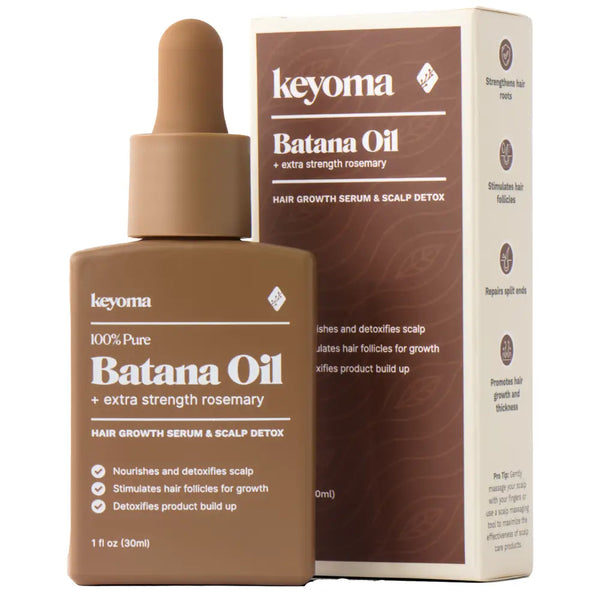
- 30-day supply $50
- 30% off for life $6
- Free haircare essentials kit $33
- Free custom wooden comb $10
- Free scalp massager $15
- Free eco-friendly travel bag $8



